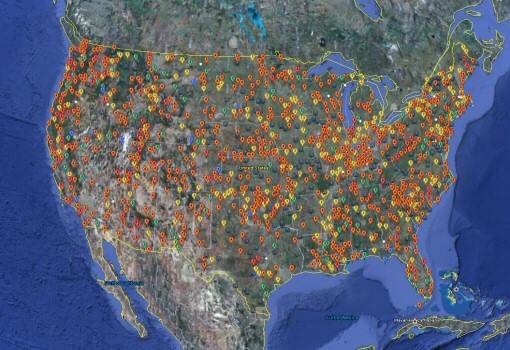Star
Gold Member
- Apr 5, 2009
- 2,532
- 614
- 190
.
If you like to fish or if you like to eat fish, climate change is going to change your hobby and your dining.
Hybrid Trout Threaten Montana's Native Cutthroats
by Christopher Joyce
May 27, 2014
Many parts of the U.S. have been getting warmer over the past several decades, and also experiencing persistent drought. Wildlife often can't adjust. Among the species that are struggling is one of the American West's most highly prized fish the cutthroat trout.
<snip>
The nonnative fish are rainbow trout. They were introduced in Western lakes and streams decades ago to give anglers more fish to catch. The rainbows mostly stayed well down in the valleys, because mountain water at higher elevations where cutthroat spawn was too cold, and the amount of water in the streams wasn't right for rainbows.
But over the past few decades, stream flow at higher elevations is down and water temperature is up. These new conditions favor rainbow trout. So rainbows are moving upstream. When they meet the cutthroat, they mate and create a hybrid essentially, a different type of trout.
<snip>
Now, you might think, so what? Surely a trout's a trout by any other name. But trout fishing brings in tens of millions of dollars (just in Montana), and lots of anglers want to catch native cutthroats they're as picky about their trout as the trout are about where they spawn.
More important, biologists like Muhlfeld who have been tracking the reproductive success of these hybrids worry that might die out too, leaving fewer fish overall. Recent genetic evidence that he and his colleagues published this week in the journal Nature suggests the hybrid trout aren't doing well at all.
<snip>
.
If you like to fish or if you like to eat fish, climate change is going to change your hobby and your dining.
Hybrid Trout Threaten Montana's Native Cutthroats
by Christopher Joyce
May 27, 2014
Many parts of the U.S. have been getting warmer over the past several decades, and also experiencing persistent drought. Wildlife often can't adjust. Among the species that are struggling is one of the American West's most highly prized fish the cutthroat trout.
<snip>
The nonnative fish are rainbow trout. They were introduced in Western lakes and streams decades ago to give anglers more fish to catch. The rainbows mostly stayed well down in the valleys, because mountain water at higher elevations where cutthroat spawn was too cold, and the amount of water in the streams wasn't right for rainbows.
But over the past few decades, stream flow at higher elevations is down and water temperature is up. These new conditions favor rainbow trout. So rainbows are moving upstream. When they meet the cutthroat, they mate and create a hybrid essentially, a different type of trout.
<snip>
Now, you might think, so what? Surely a trout's a trout by any other name. But trout fishing brings in tens of millions of dollars (just in Montana), and lots of anglers want to catch native cutthroats they're as picky about their trout as the trout are about where they spawn.
More important, biologists like Muhlfeld who have been tracking the reproductive success of these hybrids worry that might die out too, leaving fewer fish overall. Recent genetic evidence that he and his colleagues published this week in the journal Nature suggests the hybrid trout aren't doing well at all.
<snip>
.





